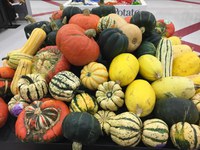Prairie Fare: Let’s Play ‘Name That Squash’
(Click an image below to view a high-resolution image that can be downloaded)
By Julie Garden-Robinson, Food and Nutrition Specialist
NDSU Extension
When I was growing up, we usually had two types of vegetables served for our evening meal.
We usually had potatoes boiled or baked in their skins and a brightly colored side vegetable. In the winter, our favorite was squash grown in our garden. It was mashed and served with a bit of butter, salt and pepper.
I enjoyed the color, texture and natural sweetness of squash. At the time, I had no idea that it was really “good for me.”
As I was picking up groceries for my family recently, I saw lots of squash neatly arranged in store displays. Some had green, orange, reddish or pale yellow skin, which usually disguises the colorful inner flesh.
Although my horticulture colleagues would say that squash botanically is the “fruit” of the plant, we in nutrition call them vegetables because of how they are used on menus. Regardless of how you classify them, enjoy more of these nutrient-rich foods on your menu.
Let’s play a little game of “name that vegetable.” The answers are all types of squash and are listed later in this column.
- This dark green squash has thick ridges and a point on the bottom. It’s green on the outside and orange on the inside. The name of this squash may make you think you have to hide them from squirrels.
- This type of squash is slightly elongated with light tan skin and orange flesh, and a nutlike flavor. I just gave you a hint.
- This small squash begins green on the vine and then turns cream-colored with bands of orange and flecks of green. Its name might make you think of a summer festival.
- This elongated, pale yellow squash has noodlelike flesh that may make you say, “Pass the marinara sauce, please.”
- This elongated squash is cream-colored with green stripes and orange flesh that is fine-textured without a “stringy” interior. (This type of squash may be less familiar to you than the others. Keep reading for a hint.)
Winter squash is a nutrition all-star and definitely worth a prominent place on your menu for health benefits and versatility.
Winter squash is an excellent source of dietary fiber, with about 6 grams of fiber per cup of squash. Orange-fleshed squash gets its color from the pigment beta carotene, which our body can convert to vitamin A. Vitamin A helps with our ability to see at night, helps maintain our skin health and serves many other functions.
Squash also provides the mineral potassium, which helps maintain our blood pressure and assists with muscle contractions and nerve signals.
When selecting squash at the grocery store, look for heavy ones without cuts or blemishes, where bacteria and other organisms can promote spoilage. Store them in a cool (45 to 50 degrees) area such as your basement or another cool location; however, avoid freezing them.
Acorn, Bush Delicata and spaghetti squash usually can be stored up to three months in a cool, dry interior location, while harder-coated buttercup and Hubbard squash can last up to six months.
You can “amp up” the nutrition in many recipes by adding squash. Try roasting small chunks of squash with potatoes and onions. Simply add your favorite cooking oil and spices, then roast in a 400 F oven until tender (30 to 40 minutes) to make a tasty side dish. Puree cooked squash and blend into oatmeal, smoothies, hummus or spaghetti sauce. Add chunks of squash to taco meat or chili.
Visit https://www.ag.ndsu.edu/fieldtofork and click on “Learn more” and then “Squash” to explore recipes and preservation information.
Have you figured out the answers to the squash quiz? Here are the answers. 1) acorn, 2) butternut, 3) carnival, 4) spaghetti, 5) Bush Delicata.
- Four to five correct: You are a squash pro!
- Two to three correct: Good try! Pick up a new type of squash the next time you are at the grocery store.
- Zero to one correct: Is it time to explore the produce aisle?
Try a variety of squash, including butternut squash, which is featured in this week’s recipe.
This recipe and nutrition analysis are courtesy of the University of Maine Cooperative Extension. A “bisque,” by the way, is a rich, creamy soup typically made with shellfish; however, this recipe calls for a variety of vegetables and some apple for sweetness.
Leeks are found near the onions in the produce section of many grocery stores. Leeks are part of the Allium family, which also includes garlic, onions, scallions and chives.
Butternut Squash Bisque
2 leeks
1 large butternut squash
3 c. low-sodium vegetable or chicken broth
2 carrots, peeled and sliced
1 apple, chopped
1 potato, peeled and chopped
1 large onion, chopped
1/4 c. fresh parsley, chopped
2 cloves garlic (or 1 Tbsp. minced garlic)
1 tsp. dried oregano
1/2 tsp. dried rosemary
1 (5-ounce) can fat-free evaporated milk
Discard the tough green leaves and root end of the leeks. Halve the leeks lengthwise and wash well to remove any dirt from between the layers. Chop coarsely. Peel, seed and coarsely chop the squash. In a 3-quart saucepan, combine leeks, squash, broth, carrots, apples, potatoes, onions, parsley, garlic, oregano and rosemary. Cover and cook over medium heat until the vegetables are tender, about 30 minutes. Puree soup in a food mill or blender, working in batches. Stir in the milk, adding more if the bisque is too thick.
Makes six (1-cup) servings. Each serving has 210 calories, 0.5 gram (g) fat, 6 g protein, 50 g carbohydrate, 8 g fiber and 140 milligrams sodium.
(Julie Garden-Robinson, Ph.D., R.D., L.R.D., is a North Dakota State University Extension food and nutrition specialist and professor in the Department of Health, Nutrition and Exercise Sciences. Follow her on Twitter @jgardenrobinson)
NDSU Agriculture Communication - Nov. 1, 2018
| Source: | Julie Garden-Robinson, 701-231-7187, julie.garden-robinson@ndsu.edu |
|---|---|
| Editor: | Ellen Crawford, 701-231-5391, ellen.crawford@ndsu.edu |



